Simple Ways To Tenderize Steak You Probably Never Thought Of, According To Chefs
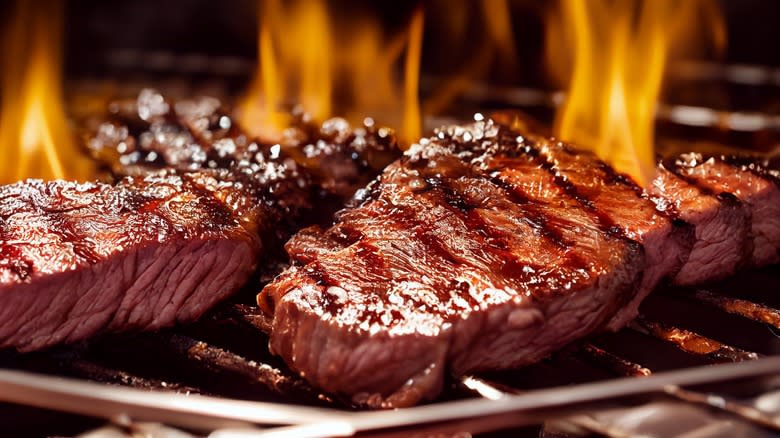
The allure of a perfectly cooked steak lies in its mouthwatering combination of tenderness, juiciness, and rich flavor. Whether it's a succulent ribeye, a tender filet mignon, or a flavorful sirloin, there's a cut to suit every preference. However, not all cuts of steak are created equal, as some are known for being tougher than others. For instance, cuts from areas of a cow that do more work, like the chuck or round, tend to be more fibrous than cuts from areas that aren't as well exercised.
Beef gets its toughness from the connective tissues that sit throughout the meat. Many tenderizing methods, like those that involve pummeling beef with a meat mallet, poking it with a fork, or cutting it, work by physically breaking down these fibers. Other tenderization techniques involve softening the meat with marinades and brines (though it's worth remembering that marinades can't move very deep into a cut of meat). Additionally, there are specific meat preparation methods that break down these stringy connective tissues.
Whatever tenderization method you choose depends on your personal preference, the specific cut of beef, and the time you have to get your meal on the table. If you don't find the idea of pummeling steak with a mallet appealing or don't have the time for a complicated marinade, never fear. Here are some other simple ways to tenderize beef you probably never considered, as recommended by chefs.
Read more: Cuts Of Steak, Ranked Worst To Best
Poke It With A Fork
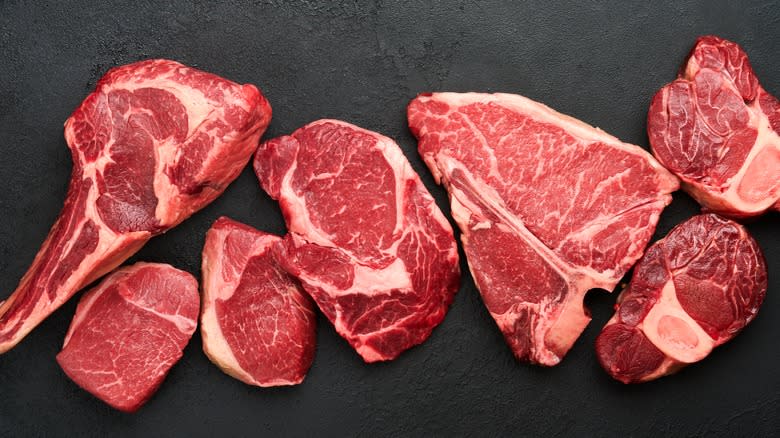
Although it might appear simple, piercing steak with a fork can have a similar effect to pounding it with a meat mallet, but with way less effort. To be more precise, poking holes in beef tears apart the tough connective tissue and muscle that can make it chewy. Furthermore, if you're looking to infuse your steak with flavor, breaking up the meat with a fork can enhance the penetration of marinades into the meat. However, it's exercise caution and avoid excessively puncturing tender cuts like ribeye, as it may give the meat a mushy texture.
While you may have to create quite a few holes on both sides of the meat for this to work, it's still a relatively fast way of softening beef employed by quite a few chefs. Moreover, you can use standard kitchen utensils without the need for any special equipment. However, if you prefer a faster tenderization method and anticipate doing this a lot, you may still want to invest in a tenderizer that uses a collection of sharp needles to penetrate the meat.
In the interest of full disclosure, not all chefs agree that puncturing steak with a fork is the best method of tenderizing beef. Rok Jurca of Pro Family Chef says that piercing raw meat can result in the loss of meat juices, and thus flavor. Other chefs contend that piercing meat can introduce bacteria into the steak if it's not cooked at a temperature above 155 degrees.
Sprinkle It With Baking Soda
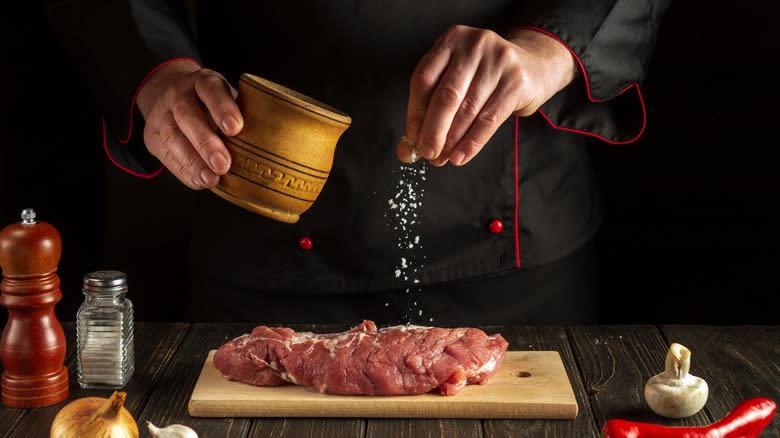
Most of us know about the benefits of sprinkling steak with salt. Not only does it make the meat more flavorful, but the seasoning can also soften it by breaking down any tough muscles and fibers close to the surface. However, not as many of us know that applying baking soda to beef can be just as effective, if not better, at tenderizing the meat. This is because baking soda actually alters the beef's chemistry. Instead of breaking up stringy connective tissues, baking soda raises the pH of the surface of the meat, making it more alkaline in a process known amongst chefs as velveting. This, in turn, helps to stop the proteins inside the meat from bonding together and toughening the meat during cooking.
According to Patricia S. York from Southern Living, baking soda can even tenderize beef faster than salt. York says that 15 to 20 minutes in a baking soda brine is sufficient to tenderize steak while the softening process with a salt brine only begins after 30 minutes. Last but not least, meat can be left in baking soda longer than in salt without fear of it turning mushy. To achieve optimal meat tenderness, Tasting Table advises calculating out the weight of the meat, then using just 1% of that weight in baking soda to create your brine.
Pop It In A Cornstarch Slurry

When it comes to tenderizing beef, cornstarch works in a similar way to baking soda, in that it can stop the proteins in the meat from seizing up during cooking by making the outside of the meat more alkaline. It also creates a shield that may lock in moisture and so stops the meat from overcooking and toughening. Also sometimes called velveting, the method of marinating beef in a cornstarch slurry is often used by chefs in Chinese restaurants to soften beef prior to the high-heat process of stir frying.
While there are different recipes for cornstarch-based marinades, Kikkoman's version calls for cornflour, whisked egg whites, table salt, and sesame oil or rice wine. Other ingredients that are also commonly thrown into the mix to optimize flavor include oyster sauce, rice vinegar, and Shaoxing wine. While marinating in cornstarch, it's common for the raw meat to take on a vibrant red hue. This is normal and nothing to worry about. To prevent any clumping, it's important to wash the marinade off the meat before cooking. For best results, pop it in a colander and rinse under running water. Alternatively, some professional chefs like Grace Young recommend briefly submerging the marinated beef in peanut oil while it cooks on the stove (via Food Network).
Submerge It In Soda

Colas are popular tenderizing tools amongst chefs, also because of their high acidity, which is great at breaking down connective tissue and tenderizing the meat. Other soft drinks are also highly acidic, which makes them an ideal — if somewhat unusual — choice for meat marinades. For comparison, grapefruits have a pH of 3.38, lemons 2.3, and lime 2.4. Meanwhile, the pH level for soft drinks falls somewhere between 2 and 4, depending on the type of beverage you're reaching for — as an example, Coca-Cola, has a relatively acidic pH of around 2.7.
Beyond their tenderizing capabilities, sodas can also imbue steak with distinctive flavors. Colas can infuse meat with a caramel flavor, cream sodas with vanilla, and lemon or lime-infused sodas lend a hint of citrus. Additionally, the sugars that are present in soft drinks can contribute to caramelization during cooking, adding a desirable crust and color to the exterior of the meat.
Various cooking publications offer up different recommendations for marinating times when using soda. While some chefs suggest that the meat can be immersed in a soda marinade for a maximum of eight hours, Tasting Table proposes an extended marinating time of up to 24 hours. If you've got the time, it may be best to experiment with different marinating times to find the one that best suits your taste preferences.
Score It With A Kitchen Knife

While you probably wouldn't use this method on a spendy tenderloin, scoring tougher cuts of meat such as flank steak or skirt steak with a kitchen knife before you start cooking can do wonders to enhance the meat's tenderness. For best results, food editor Sherry Rujikarn from Good Housekeeping recommends you start by making small ⅛" incisions across the grain. Next, slice the meat perpendicular to the initial cuts, resulting in a criss-cross pattern. Repeat on the opposite side of the cut. Scoring your steak in this way tenderizes it by physically cutting through the rope-like muscle fibers that run through the meat — the surface of it, anyway — and make it chewy.
Scoring meat can also bring a number of other benefits. Firstly, it increases the steak's surface area and lets seasoning and marinade penetrate deeper into the cut. This not only imbues the meat with flavor but also aids in the tenderizing process by allowing the marinade to permeate a larger portion of the meat, rather than merely the outer surface. In addition, making slits in the steak creates edges that will caramelize during the searing process, increasing the cut's flavor, texture, and overall appeal.
Use The Power Of Fruit
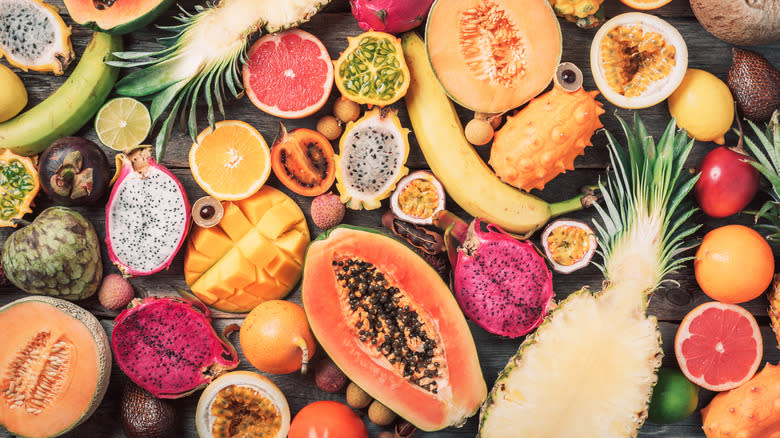
It's a well-known fact amongst chefs and home cooks alike that soaking meat in a marinade can both tenderize and add flavor to the final dish. This is largely because the acidic ingredients used in marinades not only impart meat with a robust flavor but also help to break down the connective tissues in the meat and make it more tender. While apple cider vinegar and wine are frequently the favorite go-to ingredients to increase the acidity of marinades, adding a puree made from acidic fruits such as pineapple, mangoes, and papayas can also transform chewy meat into a tender treat.
For the best outcome, add one to two tablespoons of fruit puree for each cup of marinade you are using. According to Cuisine at Home, thin cuts of meat shouldn't sit in the marinade for longer than three hours, and thicker cuts such as steak for longer than six hours. However, MasterClass recommends checking the meat periodically to ensure that it doesn't become overly soft. If you notice the edges of the steak starting to cook, it's time to remove it from the marinade.
Slow-Cook It
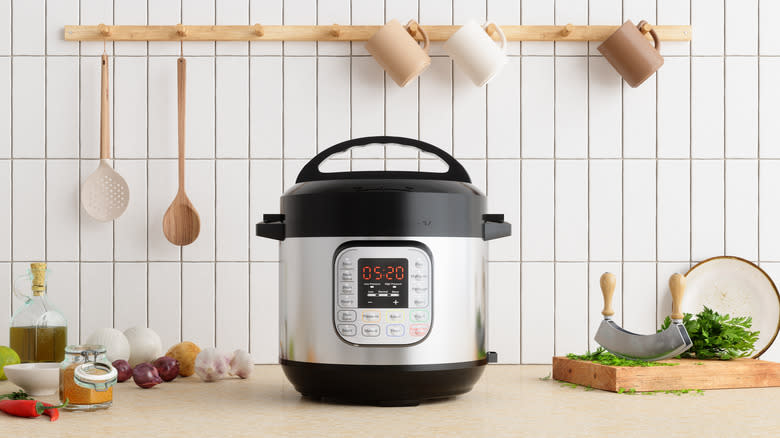
With a method that's particularly well suited to tough cuts such as brisket and chuck, preparing beef in a slow cooker breaks down the stringy muscle fibers in the meat, ideally resulting in a fall-off-the-bone tenderness. This is because tough cuts of steak are filled with collagen, which needs prolonged cooking to dissolve into gelatin and imbue the beef with rich flavor and silky texture. Even if the beef happens to dry out a little during the slow-cooking process, the gelatin will likely more than make up for this.
Anne and Sue of Science of Cooking recommend slow-cooking beef with broth or water at the highest setting for an hour and then reduce the temperature to low. The steam that results will help to break down any sinewy muscle fibers and keep the meat juicy despite the long cooking process. The low heat is also less likely to overcook the beef. Be sure to leave plenty of time for the flavors to meld and develop, which can take around four hours, depending on the size of the cut.
Use Reverse Searing
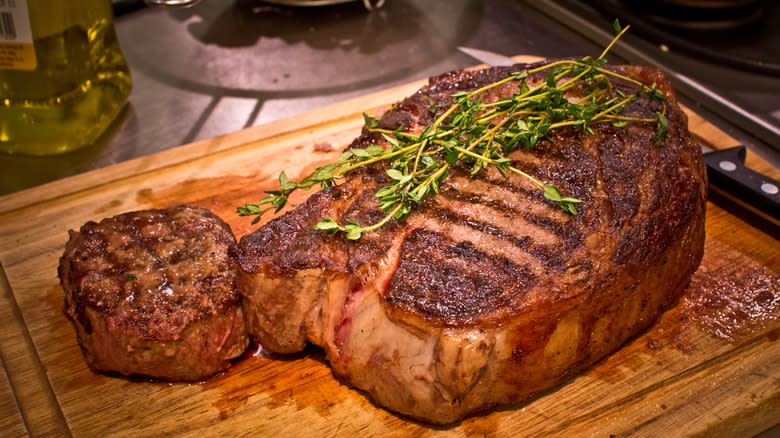
If you like your steak tender on the inside and crispy on the outside, then reverse searing (a favorite method of chef Andrew Zimmern) has got you covered. To cut a long story short, this method involves slowly cooking the steak at a low temperature in the oven, then searing it to create a flavorful crust. Gradual heating in the oven at low temperatures not only prevents overcooking but also activates the enzymes responsible for softening meat tissue. While traditional slow-cooking works best for tougher cuts of beef, reverse searing can be used with marbled and tender pieces of steak.
To reverse sear a steak, simply place it in the oven until it reaches your desired internal temperature (it's best to monitor the cut with a meat thermometer). According to MLS, this should be around 105 degrees Fahrenheit for rare, 115 degrees for medium-rare, 125 degrees for medium, and 135 degrees for medium well-done. This process should take between 20 and 40 minutes depending on the desired level of doneness.
Once out of the oven, sear the steak in a hot pan until well browned on both sides. Since time in the oven tends to leave the surface of the beef dry, it should be easy to achieve a flavorful crust. In addition, it's important to note that searing the steak won't cook the interior of the meat any further, which means that you'll need to ensure the desired level of doneness during the initial oven cooking.
Pop It In A Sous Vide Cooker

One of the greatest benefits of sous vide cooking lies in its ability to trap moisture within the food, leaving it both juicy and flavorful. Translating to "under vacuum" in French, this cooking technique involves placing food inside an air-tight, heat-safe plastic bag and submerging it in water set at a specific temperature. Not surprisingly, this cooking method also works quite well for steak. Immersing beef in water at a consistently low temperature over an extended period of time helps to break down the collagen in the meat, yielding an outcome that chefs say is comparable to using a slow cooker.
Preparing meat in temperature-controlled water also ensures that your steak is perfectly cooked to your desired level of doneness. If you set your sous vide machine to 129 degrees Fahrenheit and cook it for two hours, you'll get a perfectly cooked medium-rare steak. With the right machine, you won't even need a meat thermometer and certainly don't need to cut into the steak to see if it's done. If you want your steak cooked to medium or medium well-done, simply adjust the water temperature. Once your steak is ready, pop it in a hot pan for a short time to sear the exterior.
Be Sure To Give It A Rest

As tempting as it may be to dig into your steak immediately after you remove it from the heat, be sure to step back for a few minutes before cutting into it. This step can go a long way to ensuring you have a tender and flavorful meal. This is because when the meat is cooked, the juices concentrate in the center of the cut. This pooling can allow those juices to escape as soon as you cut into the beef, leaving it tough and dry. According to multiple professional chefs who spoke to Steak School, setting your steak aside for between two and five minutes, depending on its thickness, helps facilitate the redistribution of juices and contributes to a tender result when you finally cut into it.
Since residual heat means steak continues to cook even after you remove it from the pan, it's important to take it off the heat source a few minutes prior to reaching the desired doneness. Of course, the internal temperature of beef will vary depending on whether you like your steak, rare, medium, well-done, or somewhere in between. Celebrity chef Martha Stewart recommends that, while a medium-rare steak should reach an internal temperature of between 130 and 135 degrees Fahrenheit, you should take it off the pan while it's 115 degrees to be sure that it doesn't overcook.
Slice It Against The Grain

Slicing steak against the grain isn't just a cooking method — it's nothing short of a game-changer for your taste buds. This is because this culinary technique widely used by professional chefs can enhance both the texture and tenderness of steak to great effect. In the context of meat, the grain refers to the direction in which the bundles of muscle fibers run through the cut. When you slice across these fibers, perpendicular to their natural direction, you are shortening their length. This reduces the toughness of the meat, making it easier to chew. On the other hand, slicing steak with the grain leaves you to contend with longer muscle fibers, which can turn a cut of meat stringy and unappetizing.
Beef tends to have more pronounced muscle fibers than other meats — after all, they are powering a huge animal that typically weighs around 1,400 pounds. Cuts such as skirt steak and flank steak are particularly liable to this due to the fact that they come from the more actively-used parts of the cow. Since the connective tissues are usually grouped into bundles of between 50 and 300 strands, their direction is usually relatively easy to spot, which is great news for home chefs.
Read the original article on Mashed.

